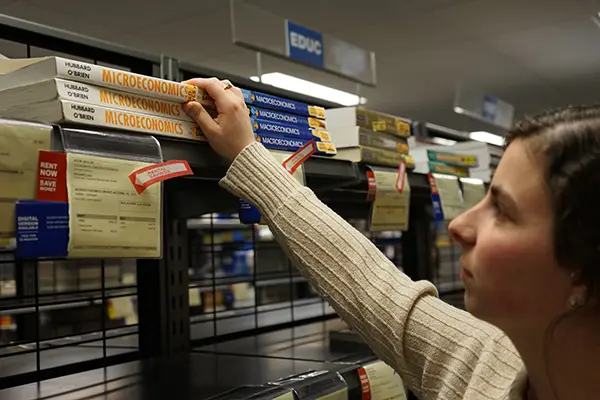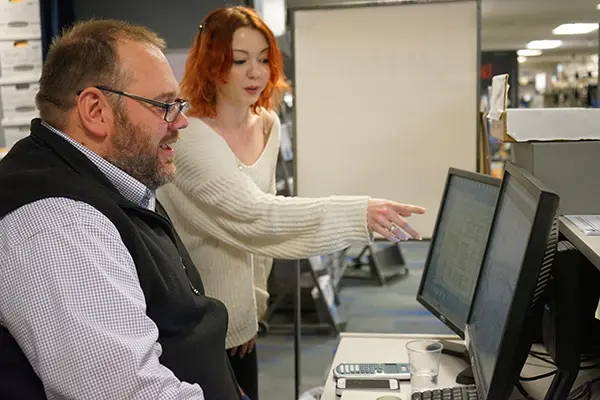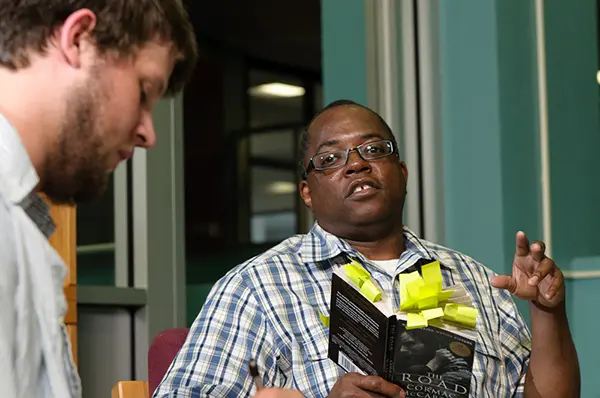Bookstore, Library and Faculty Efforts Seen as Critical to Student Success
 Image by K. Webster
Image by K. Webster
05/23/2019
By Katharine Webster
Montana Heise ’20 started out at UMass Lowell as a biology major.
But sticker shock – the $800 cost of all the science and math textbooks she was required to purchase just for her first semester – helped push her out of biology and into a double-major in sociology and world languages and cultures.
“It was a factor,” says Heise, who is paying her way through college with scholarships, a work-study job and loans. “You prioritize which books you’re going to buy. If you have to buy a book for the access code to take a test or do your homework, you buy it – but then you don’t buy other books. It’s horrible that you have to do that, because you’re at a disadvantage in those other classes.”
The high cost of textbooks has become a flashpoint in the debate over the rising cost of a college education, not only at UMass Lowell, but nationally. In part, that’s because students and their families often don’t realize how much the books will cost until the students arrive on campus, says Julie Nash, vice provost for student success.
UMass Lowell is confronting the problem directly, thanks to a dedicated committee of faculty, staff and students and the cooperation of Follett, the company that runs the campus bookstore, the River Hawk Shop.
 Image by K. Webster
Image by K. Webster
Now, the university is starting to implement solutions. Phase one is a new textbook ordering system. Phase two includes better use of library resources and technology.
“We’re getting out ahead of the problem and making great progress,” Nash says.
Two years ago, the committee surveyed faculty to find out which texts and other resources professors were already using and whether they were aware of alternatives. One frequent complaint by faculty was that it was difficult to use the textbook ordering system at the River Hawk Shop, Nash says.
University administrators have long encouraged professors to list their required texts several months before the start of each semester, so that students have a better chance of obtaining lower-cost used and rental textbooks. But the old ordering system frequently bogged down – and it didn’t show prices, professors said.
This spring, Follett rolled out a new system at UMass Lowell and other campus bookstores across the country. Follett Discover allows faculty to quickly see all the courses they teach, see the textbooks they’ve used in the past – with prices – and compare those with free, open-source texts and lower-cost alternatives popular among faculty at other universities.
“Follett Discover shows the professors pricing options and the lowest available price, where some of them haven’t even thought about that before,” says Brandi Zella ’13, ’15, who manages the River Hawk Shop’s textbook division.
Meanwhile, the libraries are working with professors who are actively trying to reduce costs for their students, and they are assembling resources that all faculty can use, says George Hart, director of libraries.
 Image by Courtesy
Image by Courtesy
Some faculty have written their own materials and use other open sources, including Math Prof. Ken Levasseur and Asst. Prof. of Spanish Hope Anderson, Hart says. Faculty here can also draw on free, open-source textbooks from other institutions.
Yet while open-source textbooks can be part of the solution, there aren’t many out there, especially for introductory and core curriculum classes, Hart says. However, the libraries can buy digital subscriptions to many textbooks, especially for more specialized, advanced courses. The Student Government Association recently agreed to support a proposed $100 increase in the mandatory technology fee, provided a portion of it is used for that purpose.
“We’ve been working with faculty who are early adopters and learning as we go,” Hart says. “They can select a book that costs the library $200 and serves 50 or more students a semester.”
Christopher Hansen, associate professor of mechanical engineering, is one of those early adopters. After he was asked to revamp a graduate class, he realized students would need two major textbooks that together cost $500. But he soon learned that the libraries had digital subscriptions that students could access for free, 24 hours a day.
“About a third of the students still bought one of the primary texts, but we saved them a lot of money,” he says.
Next, he and a mechanical engineering colleague, Assoc. Prof. Emmanuelle Reynaud, tackled the textbook used by multiple sections of a required undergraduate class, Materials Science for Engineers.
 Image by Adrien Bisson
Image by Adrien Bisson
Hansen and Reynaud found a textbook they liked. The latest edition was about $140 new, but earlier editions were similar – and students could buy them, used, at a fraction of the price. The libraries also owned a digital subscription to the first edition, which students could access online anytime.
When the textbook publisher came out with a fourth edition, Hansen asked the libraries to buy a digital subscription to the previous one at a reduced price.
“For the cost of one new textbook, the library saved our students almost $25,000, so the economics are amazing,” Hansen says. “Before that, a lot of students were not purchasing the textbook because of the cost, and they were falling behind. Now, I can confidently tell students to read the book, and in class, I can focus on higher-order thinking, problem solving and analysis.”
Hansen says he never requires students to purchase digital access codes. And he’s now “100 percent” committed to finding free or low-cost texts for every course he teaches.
On the other side of campus, Keith Mitchell, associate professor of English literature, works closely with the university libraries to assemble a list of links to online resources – known as a LibGuide – for every course he teaches. His LibGuides include critical essays, book chapters, and poems or short stories from anthologies that the library already owns, as well as movies.
Students must bring other books to class for discussion. Mitchell keeps an eye out for students who show up to class empty-handed. After class, he pulls them aside and offers them one of the copies he picks up secondhand.
Heise says she hopes the textbook initiative will raise awareness among all faculty of how prices add up for students – and that professors will make a concerted effort to lower costs.
“I hope this sparks a change at our university so that other students won't have to face the same struggles that I and many of my peers have faced,” she says.




